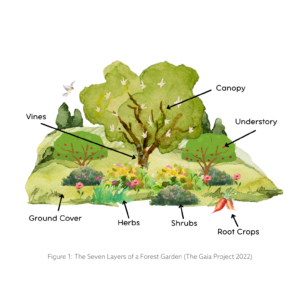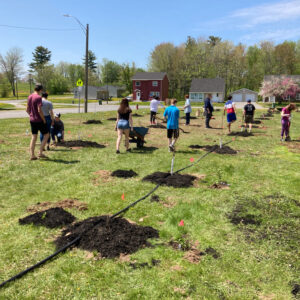Why Our Schools Need More Food Forests and Outdoor Learning Spaces
Mar 21, 2022
A food forest, (also referred to as a forest garden), is a space that is intentionally planted with a diverse assemblage of species and designed in a way that imitates and works with (not against) nature. Food forests are ‘multi-layered’ by design and will often include a canopy of larger trees, an understory of smaller fruit trees, fruit bushes, herbaceous plants, ground cover species, climbers, and root crops. (see figure 1 & 2).

Examples of plants used at New Brunswick schools include:
Canopy: Maple, Black Locust, Butternut, Mulberry
Understory: Fruit trees (Apple, Pear, Cherry, Plum, etc)
Shrubs: Currants, Haskaps, Raspberry
Herbs: Comfrey, Wildflowers, Phacelia
Groundcover: Clover, Strawberry, Blueberry
Root Crops: Sunchokes, Potatoes, Sweet Potatoes
Vines: Grapes, Hardy Kiwi
In a food forest system, it is best to include perennials (plants that return each year) as they require less maintenance and water through the summer months. The forest garden is planted densely, so as to reduce the amount of unwanted weeds (see figure 3). Another benefit to planting a diversity of plants is to help attract insects which can aid in reducing pest pressure and help pollinate other plants.
The forest garden is self-sustaining as it is planted with species that provide vital nutrients such as nitrogen, through their leaves, roots and seed pods. When incorporating a technique called ‘chop and drop mulching’ students can fertilize the garden with relative ease, reducing the need for expensive fertilizers, while providing a fun and engaging activity.
A well-designed forest garden will often include a rain garden, to better utilize rainwater runoff from nearby rooftops or parking lots. There are many creative ways to redirect the flow of rain water to help keep your garden hydrated, as mentioned in this CBC article featuring EOS Eco-Energy from Sackville.
Investigating, observing and researching optimal locations for your plants and trees can be an educational opportunity for your students. Try mapping out some spots around the school and get your students involved in the design process. Ask us about the upcoming collection of PocketLab devices we will be introducing in the 2022 Spring school year.
Many schools across New Brunswick (such as Nackawic Middle School and Oromocto High School and Port Elgin Regional School, to name a few) are recognizing the benefits that wild areas, school gardens and outdoor classrooms can have on their students and their overall learning experience.

If you aren’t yet convinced, here’s a list of reasons why your school should consider incorporating a wild area at your school:
- Learn how to grow food
- Study the life cycle of plants (from seed to soil)
- Witness the importance of pollinators and insects in our environment
- Eat wild and non-wild edible plants
- Learn about traditional uses of plants
- Study soil science and how to build soil (compost, vermicompost, soil food web)
- Provide opportunities to catch and store energy (rain water, renewable energy)
- Teach your students to be stewards of the land
- Learn about water dynamics on the landscape
- Grow food to share with the community
- To observe and interact with nature
- Teamwork, collaborative working skills
- Project management and goal setting
If you are interested in learning more about the process of planting your own school forest garden, how to receive funding or you are looking for consultation get in touch with The Gaia Project.
Author: Adam Birchweaver, Program Delivery Officer, The Gaia Project
Follow us on social for more stories, news and updates:
Facebook: www.facebook.com/gaiaproject
Instagram: @thegaiaproject_
Twitter: @gaiaproject
LinkedIn: @TheGaiaProject